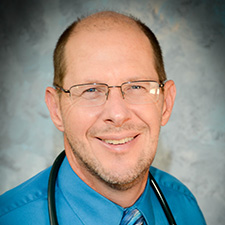The promise of more stable income, fewer administrative hassles or a bigger support network are a few of the perceived advantages of being employed by a large hospital or health system. But employment can also come with some disadvantages—both personal and professional.
AMA member Jim Milford, MD, has worked both sides of the fence, developing a network of medical clinics for a large regional medical center in Wisconsin, serving as a medical director for a hospice company and later establishing his own private physician practice.
The 4-year-old private practice is what Dr. Milford always wanted in a medical setting—one that is nimble, efficient and humane.
Dr. Milford began his career as an employed physician for a health system in Wisconsin, establishing rural medicine clinics.
For two decades, Dr. Milford built a network of clinics, rising to chief of staff and “it was very much like a private practice,” he said. But as the hospital practice grew in size, the personal relationships eroded and eventually the hospital was purchased by an organization headquartered in another state that owned scores of other hospitals and medical facilities.
“It became more and more corporate,” he recalled. Minor equipment purchases and small repairs turned into budget and scheduling snafus.
The turning point was during the periodic contract renegotiation when more salary was available but not the other management improvements or creative choices that Dr. Milford sought. He sought more freedom and creativity, not just money.
“All I want is a palette, some paints and a canvas. And I want to paint my own picture,” he told them. “And they sort of looked at me bewildered.”
It takes the same kind of astute judgement and effective collaboration with colleagues to succeed in an independent setting that it does to successfully care for patients, and the AMA offers the resources and support physicians need to start and sustain success on the path to private practice.
New beginning
In 2017, Dr. Milford founded his own practice, Three Oaks Health in Johnson Creek, Wisconsin, about halfway between Madison. and Milwaukee. The aim was to promote a more sensitive approach to patient care.
“We know that your health is not defined by doctors, insurers or bureaucrats. It’s not determined by lab values and measures. And it’s not just about living longer, it’s about living better,” says the practice’s website.
Three Oaks has 10 employees including Dr. Milford—a board-certified family physician—two certified physician assistants and a business manager, among other support staff. The practice has about 2,300 patients and maintains a physician-hospital organization with Watertown Regional Medical Center.
The practice aims to innovate in a way that allows for an individual focus on patients and a team-based approach to care. Learn more about Dr. Milford’s three keys to giving physicians more face time with patients.
Private practices have been under intense pressure for years, and the COVID-19 pandemic has exacerbated financial strain and highlighted the extensive regulatory burdens faced by physician practice owners. Learn about AMA advocacy, resources and research to help make private practice a viable option for physicians.
A sense of creativity
The practice has evolved the way Dr. Milord planned and hoped for, he said, imbued with a spirit and a sense of creativity that welcomes challenges. The COVID-19 pandemic “was invigorating,” he said, as the practice responded to the health needs as a team, designing and building its own mask sanitizer, becoming a certified vaccinator, and incorporating new technology to sanitize examination rooms and facilitate telehealth.
“We could do all that very effectively and efficiently without having to wait for some top-down decision that might delay things by two, three or six months. That allowed us to be very nimble in this phase,” he said. “And it wasn’t all about seeing patients. It was also about designing systems to keep patients safe.”
Find out more about how patient fears pushed rapid evolution at Dr. Milford’s family practice.
Post-pandemic, Dr. Milford seeks to grow his practice, but aggressive growth is not a priority. Designing new ways to achieve goals and creating ways to encourage his staff are also prioritizes. Management is a challenge to accept—not run away from.
“You can‘t turn a blind eye to the business of medicine. It impacts people directly. Part of health care is the business of medicine,” he said.
Learn more about the new AMA Private Practice Physicians Section, which seeks to preserve the freedom, independence and integrity of private practice so that physicians who choose to practice in that setting can provide compassionate personal medical care for their patients.




